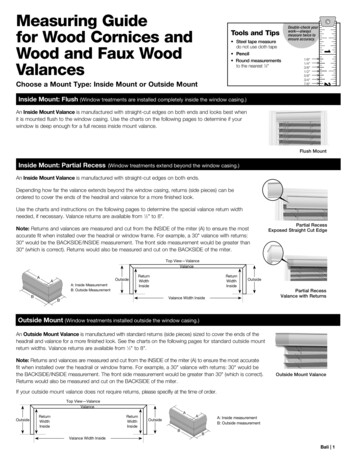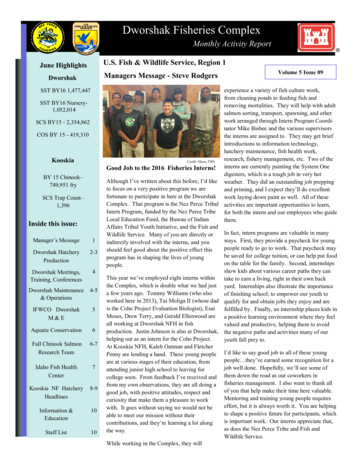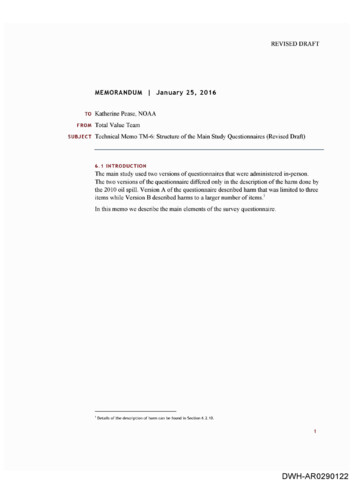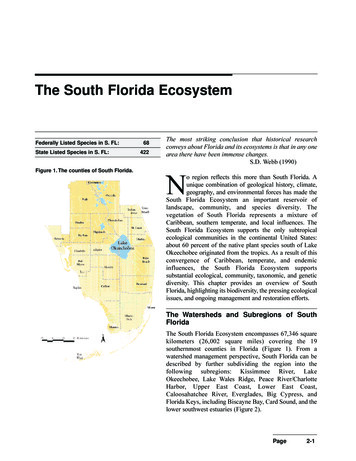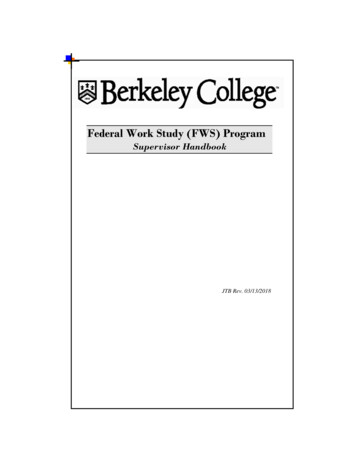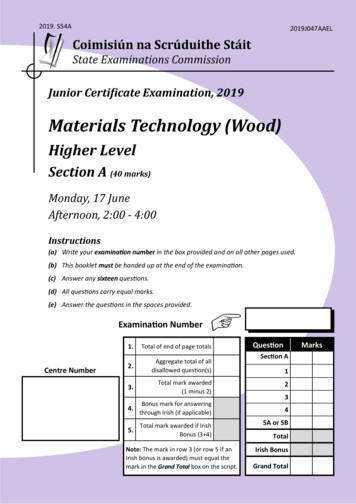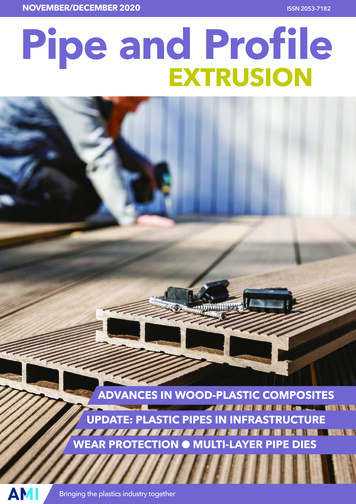
Transcription
Wood StorkMycteria americanaFederal Status:Endangered (Feb. 28, 1984)Critical Habitat:None DesignatedFlorida Status:EndangeredRecovery Plan Status:Contribution (May 1999)Geographic Coverage:South FloridaFigure 1. Florida distribution of the wood stork.0Wood storks (Mycteria americana) are one of twospecies of storks that breed in North America. Thislarge, long-legged inhabitant of marshes, cypressswamps, and mangrove swamps reaches the northern limitof its breeding range in the southeastern U.S., where itbreeds in colonies with great egrets, snowy egrets, whiteibises, and many other species. The unique feeding methodof the wood stork gives it specialized habitat requirements;the habitats on which wood storks depend have beendisrupted by changes in the distribution, timing, andquantity of water flows in South Florida. The populationdeclines that accompanied this disruption led to its listingas an endangered species and continue to threaten therecovery of this species in the U.S.This account represents South Florida s contribution tothe rangewide recovery plan for the wood stork (FWS1997).DescriptionThe wood stork is a large, long-legged wading bird, with abody length (head to tail) of 85 to 115 cm and a wingspanof 150 to 165 cm. Their plumage is white, except foriridescent black primary and secondary feathers and a shortblack tail. On adult wood storks, the rough scaly skin of thehead and neck is unfeathered and blackish in color. Theirlegs are dark with dull pink toes. The bill color is blackish.Male and female wood storks are similar in appearance,although male wood storks tend to be larger, have longerwingspans and weigh more.Immature storks, up to the age of about 3 years, differfrom adults in that their bills are yellowish or straw coloredand they exhibit varying amounts of dusky feathering onthe head and neck. During courtship and the early nestingseason, adults have pale salmon coloring under the wings,fluffy undertail coverts that are longer than the tail, andtoes that brighten to a vivid pink.Page4-393
WOOD STORKMulti-Species Recovery Plan for South FloridaIn the field, wood storks are distinctive among North American wadingbirds due to their long, heavy bills, black primary and secondary feathers, andblack tails. Few other North American wading birds, except sandhill cranes(Grus canadensis), whooping cranes (Grus canadensis americana), white ibises(Eudocimus albus), and roseate spoonbills (Ajaia ajaja) fly with their necksand legs extended. Wood storks can be distinguished from sandhill cranes bytheir white plumage; they can be distinguished from whooping cranes by theirsize (the body of wood storks are 89 to115 cm while whooping cranes are 127to151 cm), black secondary feathers, and black tail feathers. White ibises andwood storks both have black flight feathers on the wing tips. However, the woodstork is easily distinguished by its black head and its heavy bill. The roseatespoonbill is characteristically pinkish in color and has a spoonbill. At largedistances, soaring white pelicans (Pelecanus erythrorhynchos) and storksappear similar; both soar in flocks at great heights and have similar colorpatterns.TaxonomyThe wood stork is one of 17 species of true storks (Ciconiidae) in the world. Thewood stork is one of three stork species found in the western hemisphere and isthe only one that breeds north of Mexico (Ogden 1990). The wood stork has nodescribed subspecies, races, or distinctive subpopulations (Palmer 1962).DistributionBreeding populations of the wood stork occur from northern Argentina, easternPeru, and western Ecuador north to Central America, Mexico, Cuba,Hispaniola, and the U.S. (AOU 1983). In the U.S., wood storks historicallynested in all coastal states between Texas and South Carolina (Wayne 1910,Bent 1926, Howell 1932, Oberholser 1938, Dusi and Dusi 1968, Cone and HallFigure 2. Breeding distribution of the wood stork in the United States (FWS 1996).Page4-394
WOOD STORKMulti-Species Recovery Plan for South FloridaWood stork.Original photograph by BrianToland.1970, Oberholser and Kincaid 1974). Currently, wood storks breed in Florida,Georgia, and coastal South Carolina (Figures 1 and 2). Post breeding storksfrom Florida, Georgia, and South Carolina disperse occasionally as far north asNorth Carolina and as far west as Mississippi and Alabama.In the U.S., the post breeding dispersal of the wood stork is extensive, withannual variation. The wood stork has been reported both as a casual and regularvisitor, ranging from southern California and southern Arizona, north tonorthern California, southern Idaho, Montana, Colorado, Nebraska,southeastern South Dakota, Missouri, Illinois, southern Michigan, andsouthern Ontario, Canada; from the Gulf of Mexico north to Arkansas andwestern Tennessee; and along the Atlantic coast to Maine, southern NewBrunswick, Canada, and New York, south to its breeding range in Florida,Georgia, and South Carolina. It is suspected that most wood storks sighted inArkansas, Louisiana, Texas, and points farther west are birds that havedispersed from colonies in Mexico (FWS 1997). Some of the sightings in thisregion may also be wood storks dispersing from southeastern U.S. breedingcolonies, but the amount of overlap or interchange between populations in thesoutheastern U.S. and Mexico is unknown.In South Florida, breeding colonies of the wood stork occur in Broward,Charlotte, Collier, Miami-Dade, Hardee, Indian River, Lee, Monroe, Osceola,Palm Beach, Polk, St. Lucie, and Sarasota counties. Wood storks have also nestedPage4-395
WOOD STORKMulti-Species Recovery Plan for South Floridain Martin County, and at one time or another, in every county in South Florida. Itis believed that storks nesting in north Florida, Georgia, and South Carolina movesouth during the winter months (December through February). Bancroft et al(1992) have shown that the number of storks feeding in the three WCA s of thecentral and northern Everglades varied greatly among winters, ranging from a lowof 1,233 birds in a high-water year to 7,874 birds in a low-water year. In most ofthe study years, 1985 to 1989, the total number of storks in the WCA s increasedsubstantially between December and January, and dropped off sharply afterMarch. In some years, the inland marshes of the Everglades have supported themajority (55 percent) of the U.S. population of wood storks (FWS 1997).HabitatThe wood stork is primarily associated with freshwater and estuarine habitats fornesting, roosting, and foraging. Wood storks typically construct their nests inmedium to tall trees that occur in stands located either in swamps or on islandssurrounded by relatively broad expanses of open water (Palmer 1962, Rodgers etal. 1996, Ogden 1991). Historically, wood storks in South Florida establishedbreeding colonies primarily in large stands of bald cypress (Taxodium distichum)and red mangrove (Rhizophora mangle). The large, historic Everglades NPnesting colonies were in estuarine zones. These estuarine zones are also animportant feeding habitat for the nesting birds. In one study of wood stork nestingthroughout Florida, which was conducted prior to the 1960s, more than half of allwood stork nests were located in large bald cypress stands, 13 percent werelocated in red mangrove, eight percent in partially harvested bald cypress stands,six percent in dead oaks (Quercus spp.), and five percent in small pond cypress (T.distichum var. nutans) (Palmer 1962). Wood storks have also been observedconstructing their nests in custard (pond) apple (Annona glabra), black gum(Nyssa biflora), buttonwood (Conocarpus erectus), black mangrove (Avicennagerminans), strangler fig (Ficus aurea), and southern willow (Salix carolina).Coastal nest sites occur in red mangroves and, occasionally, Brazilian pepper(Schinus terebinthifolius), cactus (Opuntia stricta), and Australian pine(Casuarina equisetifolia).During the nonbreeding season or while foraging, wood storks occur in awide variety of wetland habitats. Typical foraging sites for the wood stork includefreshwater marshes and stock ponds, shallow, seasonally flooded roadside oragricultural ditches, narrow tidal creeks or shallow tidal pools, managedimpoundments, and depressions in cypress heads and swamp sloughs. Because oftheir specialized feeding behavior, wood storks forage most effectively inshallow-water areas with highly concentrated prey (Ogden et al. 1978, Browder1984, Coulter 1987). In South Florida, low, dry-season water levels are oftennecessary to concentrate fish to densities suitable for effective foraging by woodstorks (Kahl 1964, Kushlan et al. 1975). As a result, wood storks will forage inmany different shallow wetland depressions where fish become concentrated,either due to local reproduction by fishes, or as a consequence of seasonal drying.The loss or degradation of wetlands in central and South Florida is one of theprincipal threats to the wood stork. Nearly half of the Everglades has been drainedfor agriculture and urban development (Davis and Ogden 1994). The EvergladesPage4-396
WOOD STORKMulti-Species Recovery Plan for South FloridaAgricultural Area (EAA) alone eliminated 802,900 ha of the original Everglades,and the urban areas in Miami-Dade, Broward and Palm Beach counties havecontributed to the loss of spatial extent of wood stork habitat. Everglades NP haspreserved only about one-fifth of the original extent of the Everglades, and areasof remaining marsh outside of the Everglades NP have been dissected intoimpoundments of varying depths.The U.S. Army Corps of Engineers (COE) Central and Southern Florida(C&SF) Project encompasses 4,660,000 ha from Orlando to Florida Bay andincludes about 1,600 km each of canals and levees, 150 water control structures,and 16 major pump stations. This system has disrupted the volume, timing, anddirection of fresh water flowing through the Everglades. The natural sheet flowpattern under which the Everglades evolved since about 5,000 years ago has notexisted for about 75 years (Leach et al. 1972, Klein et al. 1974). The diversionof natural sheet flow to canals, the loss of fresh water to seepage and to pumpingto tidal waters, and the extraction of fresh water for irrigation and urban watersupply has led to saltwater intrusion in coastal counties from St. Lucie County onthe east coast to Sarasota County on the west coast.Although the major drainage works completed the conversion of wetlands toagriculture in the EAA by about 1963, loss of wetlands continues to the presentat a slower, but significant rate. In the entire State of Florida between the mid1970s to the mid-1980s, 105,000 ha of wetlands (including marine and estuarineoffshore habitats) were lost; we do not have an estimate for freshwater wetlandsin central and south Florida (Hefner et al. 1994).BehaviorCourtshipMating occurs after a period of highly ritualized courtship displays at the nest site(Kahl 1972). As a female bird approaches, male birds establish themselves atpotential nest sites and perform ritualized preening behavior. Rival males willextend their necks, grab their opponents bills, and clatter their bills loudly a fewtimes. Females respond by bill gaping and a spread-winged balancing posture.Females will be turned away initially, but after repeated approaches, will respondby swaying their heads, preening, or playing with nearby twigs (Kahl 1972).During copulation, males loudly clatter their bills. Mated pairs greet each otherwith exaggerated, mutual up-down head movements and hissing calls.ReproductionWood storks tend to use the same colony sites over many years, as long as thesites remain undisturbed and sufficient feeding habitat remains in thesurrounding wetlands. Site turnover rates for the colonies in South Carolina arevery low at 0.17 colonies per year. Current year colonies have an 89 percentlikelihood of remaining active in consecutive years. However, many of theseSouth Carolina colonies are relatively recent.Traditional wetland nesting sites may be abandoned by storks once local orregional drainage schemes remove surface water from beneath the colony trees.Maintaining adequate water levels to protect nests from predation is a criticalPage4-397
WOOD STORKMulti-Species Recovery Plan for South Floridafactor affecting production of a colony. The lowered water levels allow nestaccess by raccoons and other land-based predators. As a result of such drainagesand predation, many storks have shifted colony sites from natural to managed orimpounded wetlands. The percentage of wood storks that nested in either alteredwetlands (former natural wetlands with impounded water levels) or artificialwetlands (former upland sites with impounded water) in central and north Floridacolonies increased from about 10 percent in 1960 to between 60 and 82 percentbetween 1976 and 1986.Wood storks are seasonally monogamous, probably forming a new pair bondevery season. Three and 4-year-old birds have been documented to breed, but theaverage age of first breeding is unknown. Once wood storks reach sexualmaturity they are assumed to nest every year; there are no data on whether theybreed for the remainder of their life or whether the interval between breedingattempts changes as they age (FWS 1997).Wood storks construct their nests in trees that are usually standing in wateror in trees that are on dry land if the land is a small island surrounded by water.The nest are large rigid structures usually found in the forks of large branches orlimbs. Storks may add guano to the nest to stabilize the twigs. (Rodgers et al.1988). The nest may be constructed in branches that are only a meter above thewater or in the tops of tall trees. They construct their nests out of sticks, with alining of finer material. Their nests are flat platforms, up to 1 m in diameter, andare maintained by the adult storks throughout the breeding season. Although bothadults maintain the nest, the male wood stork usually brings nest material to thefemale after they complete their courtship (Palmer 1962).The date on which wood storks begin nesting varies geographically. InFlorida, wood storks lay eggs as early as October and as late as June (Rodgers1990). In general, earlier nesting occurs in the southern portion of the state(below 27 N). Storks nesting in the Everglades and Big Cypress basins, underpre-drainage conditions (1930s to 1940s), formed colonies between Novemberand January (December in most years) regardless of annual rainfall and waterlevel conditions (Ogden 1994 and 1998). In response to deteriorating habitatconditions in South Florida, wood storks in these two regions have delayed theinitiation of nesting, approximately two months, to February or March in mostyears since the 1970s. This shift in the timing of nesting is believed to beresponsible for the increased frequencies of nest failures and colonyabandonment in these regions over the last 20 years; colonies that start afterJanuary in South Florida risk having young in the nests when May-June rainsflood marshes and disperse fish.Female wood storks lay a single clutch of eggs per breeding season.However, they will lay a second clutch if their nests fail early in the breedingseason (M. Coulter 1996). Wood storks lay two to five (usually three) eggsdepending on environmental conditions; presumably larger clutch size in someyears are responses to favorable water levels and food resources. Once an egg hasbeen laid in a nest, one member of the breeding pair never leaves the nestunguarded. Both parents are responsible for incubation and foraging (Palmer1962). Incubation takes approximately 28 days, and begins after the first one ortwo eggs are laid; therefore egg-hatching is asynchronous.Younger, smaller chicks are often the first to die during times of food stress(FWS 1997). It takes about 9 weeks for the young to fledge; once they fledge, thePage4-398
WOOD STORKMulti-Species Recovery Plan for South Floridayoung stay at the nest for an additional 3 to 4 weeks to be fed by their parents.Parents feed the young nestlings by regurgitating whole fish into the bottom ofthe nest; parents feed the young three to 10 or more times per day. Largernestlings are fed directly bill to bill. Feedings tend to be more frequent whenyoung are small. Ogden et al. (1978) reported that only one to two feedings perday, per nest, have been recorded in South Florida colonies when adults wereforced to fly great distances to locate prey. Kahl (1964) calculated that an averagewood stork family (two adults and two nestlings) requires 201 kg (443 lbs) of fishduring a breeding season, and that a colony of 6,000 nests therefore requires1,206,000 kg of fish during the breeding season. A similar calculation for atypical Everglades NP or Corkscrew Swamp colony with 200 nests wouldrequire 40, 200 kg (88,600 lbs) of fish during the breeding season.The production of wood stork colonies varies considerably between yearsand locations, apparently in response to differences in food availability; coloniesthat are limited by food resources may fledge an average of 0.5 to 1.0 young peractive nest; colonies that are not limited by food resources may fledge between2.0 and 3.0 young per active nest (Ogden 1996a).ForagingWood storks use a specialized feeding behavior called tactolocation, or gropefeeding. A foraging wood stork wades through the water with its beakimmersed and partially open (7 to 8 cm). When it touches a prey item, a woodstork snaps its mandibles shut, raises its head, and swallows what it has caught(Kahl 1964). Regularly, storks will stir the water with their feet, a behaviorwhich appears to startle hiding prey (Rand 1956, Kahl 1964, Kushlan 1979).Tactolocation allows storks to feed at night and use water that is turbid ordensely vegetated. However, the prey must be concentrated in relatively highdensities for wood storks to forage effectively. The natural hydrologic regimein South Florida involves seasonal flooding of extensive areas of the flat, lowlying peninsula, followed by drying events which confine water to ponds andsloughs. Fish populations reach high numbers during the wet season, butbecome concentrated into smaller areas as drying occurs. Consumers, such asthe wood stork, are able to exploit high concentrations of fish in drying poolsand sloughs. In the pre-drainage Everglades, the dry season of South Floridaprovided wood storks with ideal foraging conditions by concentrating preyspecies in gator holes and other drainages in the Everglades basin. In coastalareas, the tidal cycle strongly influences use of saltwater habitats by woodstorks. The relatively great tidal amplitudes characteristic of coastal marshes innortheast Florida, Georgia, and South Carolina serve to concentrate prey.similarly to the seasonal drawdowns found in freshwater systems (FWS 1997).Storks forage in a wide variety of shallow wetlands, wherever prey reachhigh enough densities, and in water that is shallow and open enough for thebirds to be successful in their hunting efforts (Ogden et al. 1978, Browder1984, Coulter 1987). Good feeding conditions usually occur in relatively calmwater, where depths are between 10 and 25 cm, and where the water column isuncluttered by dense patches of aquatic vegetation (Coulter and Bryan 1993).In South Florida, dropping water levels are often necessary to concentrate fishPage4-399
WOOD STORKMulti-Species Recovery Plan for South Floridato suitable densities (Kahl 1964, Kushlan et al. 1975). In east-central Georgia,where stork prey is almost twice as large as the prey in Florida, wood storksfeed where prey densities are significantly lower than foraging sites in Florida(Coulter 1992, Coulter and Bryan 1993, Depkin et al. 1992). Typical foragingsites throughout the wood stork s range include freshwater marshes and stockponds, shallow, seasonally flooded roadside or agricultural ditches, narrowtidal creeks or shallow tidal pools, managed impoundments, and depres
supply has led to saltwater intrusion in coastal counties from St. Lucie County on the east coast to Sarasota County on the west coast. Although the major drainage works completed the conversion of wetlands to agriculture in the EAA by about 1963, loss of wetlands continues to the present at a slower, but significant rate.File Size: 373KB
